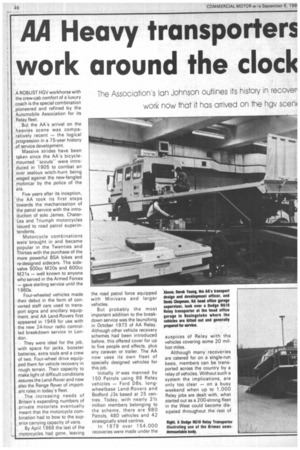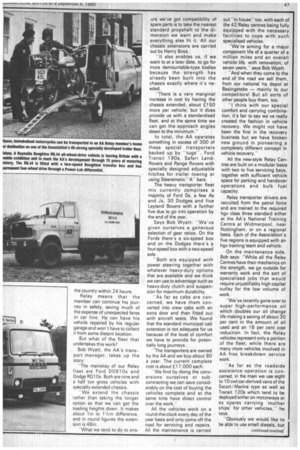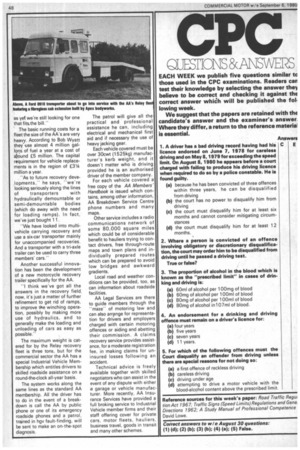AA Heavy transporters work around the clock
Page 48

Page 49

Page 50

If you've noticed an error in this article please click here to report it so we can fix it.
A ROBUST HGV workhorse with the crew-cab comfort of a luxury coach is the special combination pioneered and refined by the Automobile Association for its Relay fleet.
But the AA's arrival on the heavies scene was comparatively recent — the logical progression in a 75-year history of service development.
Massive strides have been taken since the AA's bicyclemounted "'scoutswere introduced in 1905 to combat an over zealous witch-hunt being waged against the new-fangled motorcar by the police of the era.
Five years after its inception, the AA took its first steps towards the mechanisation of the patrol service with the introduction of solo James, ChaterLea and Triumph motorcycles issued to road patrol superintendents.
Motorcycle combinations were*broubht in and became popular in the Twenties and Thirties with the purchase of the more powerful BSA bikes and re-designed sidecars. The sidevalve 500cc M20s and 600cc M21s — well known to anyone who served in the Armed Forces — gave sterling service until the 1960s.
Four-wheeled vehicles made their debut in the form of converted staff cars used to transport signs and ancillary equipment, and AA Land-Rovers first appeared in 1949 for use with the new 24-hour radio controlled breakdown service in London They were ideal for the job, with space for jacks, booster batteries, extra tools and a crew of two. Four-wheel drive equipped them for vehicle recovery in rough terrain. Their capacity to make light of difficult conditions assures the Land-Rover and now also the Range Rover of important roles in today's fleet.
The increasing needs of Britain's expanding numbers of private motorists eventually meant that the motorcycle combination had to bow to the superior carrying capacity of vans.
By April 1968 the last of the motorcycles had gone, leaving the road patrol force equipped with Minivans and larger vehicles.
But probably the most important addition to the breakdown service was the launching in October 1973 of AA Relay. Although other vehicle recovery schemes had been introduced before, this offered cover for up to five people and effects, plus any caravan or trailer. The AA now uses its own fleet of specially designed vehicles for this job.
Initially it was manned by 150 Patrols using 86 Relay vehicles — Ford D8s, longwheelbase Land-Rovers and Bedford J3s based at 25 centres. Today, with nearly 21/2 million members belonging to the scheme, there are 980 Patrols, 480 vehicles and 42 strategically sited centres.
In 1979 over 154,000 recoveries were made under the auspices of Relay with the vehicles covering some 20 million miles.
Although many recoveries are catered for on a single-run basis, members can be transported across the country by a relay of vehicles. Without such a system the implications, are only too clear — on a busy weekend when up to 1,000 Relay jobs are dealt with, what started out as a 200-strong fleet in the West could become dissipated throughout the rest of the country within 24 hours.
Relay means that the member can continue his jour ney in safety, saving much of the expense of unexpected fares or car hire. He can have his vehicle repaired by his regular garage and won't have to collect it from some distant location.
But what of the fleet that undertakes this work?
Bob Wyatt, the AA's transport manager, takes up the story: "The mainstay of our Relay fleet are Ford 0091 Os and Dodge RG10s. Both are nine and a half ton gross vehicles with specially extended chassis.
We extend the chassis rather than taking the longer option so that we can get the loading heights down. It makes about 1 in to 11/2in difference, and in round figures the extension is 48in.
What we tend to do to ens ure we've got compatibility of spare parts is to take the nearest standard propshaft to the dimension we want and make everything else fit it. All our chassis extensions are carried out by Henry Boys.
"It also enables us, if we want to at a later date, to go for more demountable-type bodies because the strength has already been built into the chassis exactly where it's needed.
"There is a very marginal increase in cost by having the chassis extended, about £150 more per vehicle, but it does provide us with a standardised fleet, and at the same time we can get the approach angles down to the minimum."
In total, the AA operates something in excess of 300 of these special transporters backed up by "tugs'', Ford Transit 190s, Safari LandRovers and Range Rovers with specially designed adjustable hitches for trailer towing or using Steeramatic "A" bars.
The heavy transporter fleet mix currently comprises a majority of Ford Ds, a few As and Js, 30 Dodges and five Leyland Boxers with a further five due to go into operation by the end of the year.
Says Bob Wyatt: "We've given ourselves a generous selection of gear ratios. On the Fords there's a six-speed box and on the Dodges there's a four-speed box with a two-speed axle.
"Both are equipped with power steering together with whatever heavy-duty options that are available and we think we can use to advantage such as heavy-duty clutch and suspension for maximum durability.
"As far as cabs are concerned, we have them converted into crew cabs with an extra door and then fitted out with aircraft seats. We found that the standard municipal cab extension is not adequate for us because of the level of comfort we have to provide for potentially long journeys.
-The transporters are owned by the AA and we buy about 90 a year. The current complete cost is about El 7,000 each.
"We find by doing the conversions ourselves or subcontracting we can save considerably on the cost of buying the vehicles complete and at the same time have direct control over the work.'" All the vehicles work on a round-the-clock every day of the year basis and only come off the road for servicing and repairs. All the maintenance is carried out "in house" too, with each of the 42 Relay centres being fully equipped with the necessary facilities to cope with such specialised vehicles.
"We're aiming for a major component life of a quarter of a million miles and an overall vehicle life, with renovation, of seven years," says Bob Wyatt.
"And when they come to the
end of the road we sell them, from our national hq depot at Basingstoke — mainly to our competitors! But all sorts of other people buy them, too.
"I think with our special comfort and carrying combination, it's fair to say we've really created the fashion in vehicle recovery. We might not have been the first in the recovery business but we have broken new ground in pioneering a completely different concept in vehicle recovery."
All the new-style Relay Cen tres are built on a modular basis with two to five servicing bays, together with sufficient vehicle space for parking and handover operations and bulk fuel capacity.
Relay transporter drivers are recruited from the patrol force and are trained to the required hgv class three standard either at the AA's National Training Centre at Widmerpool, near Nottingham, or on a regional basis. Each of the Association's five regions is equipped with an hgv training team and vehicle.
On the maintenance side, Bob says: "While all the Relay Centres have their mechanics on the strength, we go outside for warranty work and the sort of specialised jobs that would require unjustifiably high capital outlay for the low volume of work.
"We've recently gone over to super high-performance oil which doubles our oil change life making a saving of about 30 per cent in the amount of oil used and an 18 per cent cost reduction. In fact, the Relay vehicles represent only a portion of the fleet, while there are many niore vehicles involved in AA free breakdown service work.
'As far as the roadside assistance operation is concerned, in the main we use eight to 10 cwt car-derived vans of the Escort/Marina type as well as Transit 120s which tend to be deployed either on motorways or as spares carrying 'mother ships' for other vehicles,'" he says.
"Obviously we would like to be able to use small diesels, but as yet were still looking for one that fits, the bill."
The basic running costs for a fleet the size of the AA's are very heavy. According to Bob Wyatt
they use almost 4 million gallons of fuel a year at a cost of a,Vound £5 million. The capital requirement for vehicle replacements is in the region of £31/4 million a year.
"As to future recovery developments, he says, -we're
looking seriously along the lines of transporters with hydraulically demountable or semi-demountable bodies (which do away with the need for loading ramps). In fact, we've just bought 11.
"We have looked into multivehicle carrying recovery and use a six-car transporter mainly for unaccompanied recoveries. And a transporter with a tri-axle trailer can be used to carry three members' cars."
Another successful innovation has been the development of a new motorcycle recovery trailer specifically for the AA.
"I think we've got all the answers in the recovery field. now, it's just a matter of further refinement to get rid of ramps, to improve tine winching operation, possibly by making more use of hydraulics, and to generally make the loading and unloading of cars as easy as possible."
The maximum weight is catered for by the Relay recovery fleet is three tons, but for the commercial sector the AA has a special Industrial Vehicle Membership which entitles drivers to skilled roadside assistance on a round-the-clock all-year basis.
The system works along the same lines as the standard AA membership. All the driver has to do in the event of a breakdown is call the AA by public phone or one of its emergency roadside phones and a patrol, trained in hgv fault-finding, will be sent to make an on-the-spot diagnosis. The patrol will give all the practical and professional assistance he tan, including electrical and mechanical first aid and if necessary the use of heavy jacking gear.
Each vehicle covered must be over 30cwt (1525kg) manufacturer's kerb weight, and it doesn't matter who is driving provided he is an authorised driver of the member company.
For each vehicle covered a free copy of the AA Members' Handbook is issued which contains, among other information, AA Breakdown Service Centre phone numbers and many maps.
Other service includes a radio communications network of some 80,000 square miles which could be of considerable benefit to hauliers trying to contact drivers, free through-route maps and town plans and individually prepared routes which can be prepared to avoid low bridges and awkward gradients.
Local road and weather conditions can be provided, too, as can information about roadside facilities.
AA Legal Services are there to guide members through the "maze" of motoring law and can also arrange for representation for drivers and employers charged with certain motoring offences or aiding and abetting their commission. A claims recovery service provides assistance, for a moderate registration fee, in making claims for uninsured losses following an accident.
Technical advice is freely available together with skilled negotiators who can assist in the event of any dispute with either a garage or vehicle manufacturer. More recently, AA Insurance Services have provided a full broking service to Industrial Vehicle member firms and their staff offering cover for private cars, motor fleets, hauliers, business travel, goods in transit and many other schemes.




































































































































